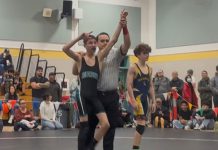In the past three days, letters from three teachers have
appeared in The Dispatch. All of them have been enlightening. I
don’t know David Fenley Clark, but he told us that he is a retired
teacher.
In the past three days, letters from three teachers have appeared in The Dispatch. All of them have been enlightening. I don’t know David Fenley Clark, but he told us that he is a retired teacher. His kind words of appreciation for the ongoing work of the Alliance for Academic Excellence give me resolve to keep going. I am hoping he will consider a run for the school board.
The following statement from his letter bears repeating: “I was a complete failure at getting non-parenting parents to parent in regard to schoolwork and I was a complete failure at getting non-studying students to study on their own, away from school. I have no idea how you might attack these problems since everything I tried failed.”
The truth is that the Alliance can not solve these problems. Nor can a school board or an administrator. All they can do is make a good public school education available for those who choose it. Non-parenting parents are the biggest obstacle to student success. A parent is the most influential person in the life of a child, even a bad parent. Parents must buy in to the education of their children, and students must be instilled with the belief that education is a precious gift. When education is not a priority in the home, there is no outside force that can overcome that obstacle. The best a teacher can do is to try to light the remaining spark inside one of those disaffected students that might awaken a passion for learning.
A substitute teacher, Alan Johnson, enlightened us with his memories. The things that stood out for me in that list were the following: “I learned that some kids seem to never have a pencil, pen or paper but have a great selection of musical CDs and a working cellular phone. These same students will ask if I have extra batteries.
I learned that most students are willing to help take roll, clean the board, pass out papers, make copies, and help other students with their work (thank you).
I learned that some students know more four letter words than I do.”
Being a substitute teacher is one of the hardest jobs in education. It is nice to know that Mr. Johnson is able to handle his job with such good humor. Nearly all the kids that I have met at Gilroy High are good kids. I don’t think you will find a nicer bunch of students at any high school in Santa Clara County. I have also been impressed that I don’t hear a lot of cussing when I am on campus, certainly not as much as I hear at the mall. I may battle for a more rigorous academic program, but I do so because I believe that we are blessed with a wonderful group of students who deserve the best.
Finally, teacher Wayne Scott’s latest includes the following questions regarding the low SAT scores at Gilroy High:
1. Is the “brain drain” reported by the Alliance for Academic Excellence real or imagined? If the drain is real, what has been the effect on SAT scores?
2. Have the demographics of SAT test takers in Gilroy changed?
3. Has the percentage of students taking the test changed?
The “brain drain” reported by the Academic Alliance is real, but improving. The number of students who leave Brownell and South Valley for private schools has been decreasing for the past two years. There have always been Gilroy families who sent their children to private schools for a myriad of reasons, and there always will be. Additionally, many those kids who left Gilroy Unified a year or two ago are coming back. The implementation of honors classes at the freshman and sophomore level is probably the main reason for this, although the economy probably had an effect as well. The demographics of Gilroy are changing. The building of all the new houses in town translates into more middle and upper-middle class folks in Gilroy than there used to be.
I don’t purport to know the answers to all of Mr. Scott’s questions. I do know that Live Oak High School students routinely score higher on the SATs then Gilroy High students. The fact remains that 73 percent of Live Oak seniors and 85 percent of GHS seniors scored lower than 1000 on their SATs, and neither school should be proud.
The national average on the SATs is over 1000, but the vast majority of Gilroy High students can’t reach that benchmark. Mr. Fenley Clark hit the nail on the head with his “guesstimates.” That minority of students who put in the required effort to master their subjects are the ones who are successful on the SATs. In Gilroy, that would be those 15 percent who did score over 1000 on the College Board exam.













